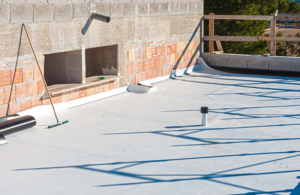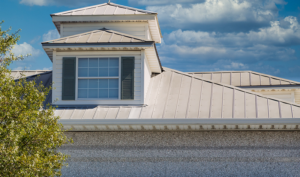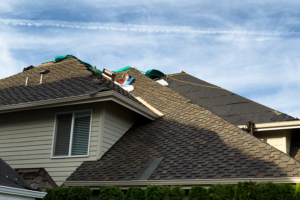In 2020, the United States experienced roof hail damage from 4,611 large hail storms, according to the NOAA Severe Weather Database. Falling hail gets caught in circular updrafts, contacts water vapor, and freezes again. The stronger the updrafts, the longer a hailstone circulates up and down until gravity no longer allows it to remain aloft, and at that point, the hailstone falls to the ground. Roof hail damage differs according to hailstone size, wind speed, wind direction, roof material and age, and slope. Damage can be functional or cosmetic, but broken edges and granule loss that appear cosmetic can cause serious complications.
Look For Roof Hail Damage After A Hail Storm
Severe roof damage like roof shingles ripped off or tree branches down is apparent. But signs of hail damage can be challenging to detect. A professional will know to first look at the gutters. High-impact hail that causes roof damage will most likely dent your gutters and downspouts. This is the easiest place to see and evaluate when looking for signs of roof damage. If there are dents and dings on your gutters and downspouts, you’re likely to have problems on the roof. Gutters can also fill up and clog due to granule loss from impact. Also, any damage to siding or decks indicates likely roof damage.
Hail smaller than 1 inch in diameter can cause damage to a roof or to other areas of your house. After a hailstorm, the hail’s size can be a first indicator as to what types of damage you may have experienced. It’s not just the size of the hailstone but also the amount. Measured in inches, large hail accumulations of smaller sizes can create leaks and damaged gutters. A hail size of 2 inches in diameter or larger will cause significant damage to your property, and the cost of repairs can vary considerably.
We recommend that you call a roofing contractor with experience working with insurance companies on a claim for hail damage immediately after this type of storm event, and be sure to keep up to date with your homeowner’s insurance policies. If needed, your hail damage claim will progress more smoothly. Your insurance provider will know the average cost of hail claims in your area, especially after significant hail storms have come through. Bad hail storms and major hail events can create golf-ball-size hail, These storms number in the thousands each year, generating millions and even billions of dollars in damages. Texas has been the number one State for the costliest hail storms for several years.
In areas that only get hail on occasion, many people may have insurers that do not adequately cover hail damage. As conditions change and the potential of hail damage increases, your peace of mind is essential. Now is the time to make sure your insurance covers hail and check hail safety tips for your area.
Granule Loss And Cracks In The Shingles
Granules cover the surface of an asphalt shingle. When a shingle loses granules, its asphalt coating is exposed to the elements, leading to accelerated aging. Look in your gutters and downspouts after a hailstorm to see if any granules have come off your shingles. Hard hail impacts or high winds can grip the shingles and cause cracks. This can lead to exposure and tears, leaving your roof with bare spots, shingle separation, and exposure to either the asphalt or fiberglass underneath. A weakened self-seal strip can contribute to shingle loss.
While these are the common types of damage we see on asphalt shingles, hail can crack or even shatter more rigid materials like clay or tile. This type of damage will be easy to see, but when you consider something like hail impact marks, you start to see how a roofing expert can help spot small, important details. If you find more than one instance of a dented gutter or damage to your siding, you should seriously consider a hail damage roof inspection. Roof damage can quickly turn into leaks or ice dams, which can also be caused by heavy hailstone accumulations. These eventually turn into mold damage, electrical issues, or rotting wood, all of which are expensive to repair.
If your home was damaged, it’s crucial to find a roofing contractor that you can trust and has experience working on projects for which homeowners have filed hail damage insurance claims. A typical homeowner insurance policy will include coverage for roof damage from hail, but coverage may be applied differently depending on where you live, your insurer, and the details of your homeowner’s policy.
Shingles can react differently when struck during frequent hail storms depending on the type of hail, wind conditions, and temperature. For example, hail damage to asphalt and composition shingles can look very different from hail damage to wood shingles. It is important to know the different effects to correctly identify whether or not you have roof damage from hail.
A professional hail damage inspection can help with this. Displacement of granules occurs from the impact of hailstones hitting the roof. The loss of protective granules exposes the underlying asphalt to the sun. When asphalt is directly exposed to the sun, without a protective layer of granules, the shingle becomes vulnerable to UV light degradation and oxidation that can accelerate cracking, blistering, bio-fouling, edge damage, and eventually water leaks. There are many other types of damage to shingles that can be mistaken for severe hail damage. For example, exposure to inclement weather and sunlight makes shingles brittle and gives them an aged appearance. This type of damage is normal wear and tear of shingles, which is sometimes misidentified as hail damage. Other types of normal wear and tear may include blistering, cracking, granule loss, and flaking. Manufacturing defects and mechanical imperfections in shingles can also be mistaken for hail damage.
Besides being a sign of further hail damage on the roof, a damaged air conditioner may qualify for insurance replacement. Vents, chimneys, skylights, valley flashings, and other features may also have been damaged and should be checked carefully.
Preparing For Future Storms
Severe storms are becoming more frequent and intense. Organic asphalt shingles are the least resistant to impact and also the most common. Depending on the extent of hail storms and the severity of hail storms, a one-inch hailstone can cause damage. Fiberglass asphalt shingles hold up better, and if you are considering a roof replacement, you may want to use a more substantial shingle. Thirty-year laminated shingles are much more resistant to both hail and wind, and this type of shingle may be your best choice.
A professional inspection from our experts at Blue Nail Roofing can provide the guidance you need to make the right decision for your situation.
RESOURCES
Blue Nail Roofing has a Master Elite contractor status awarded by the largest roofing manufacturer in North America, GAF. Only 2% of contractors in the US meet the rigorous standards to achieve this status, which means you can be assured you are making a good choice when you select the professionals at Blue Nail to execute your home and business roofing repairs. Call today to schedule a professional evaluation!
Copyright © 2020 Blue Nail Enterprises. All rights reserved. | Privacy Policy
Let Us Nail Your Project!
Send us a little information about your roofing or home improvement needs, and an expert will soon reach out.







